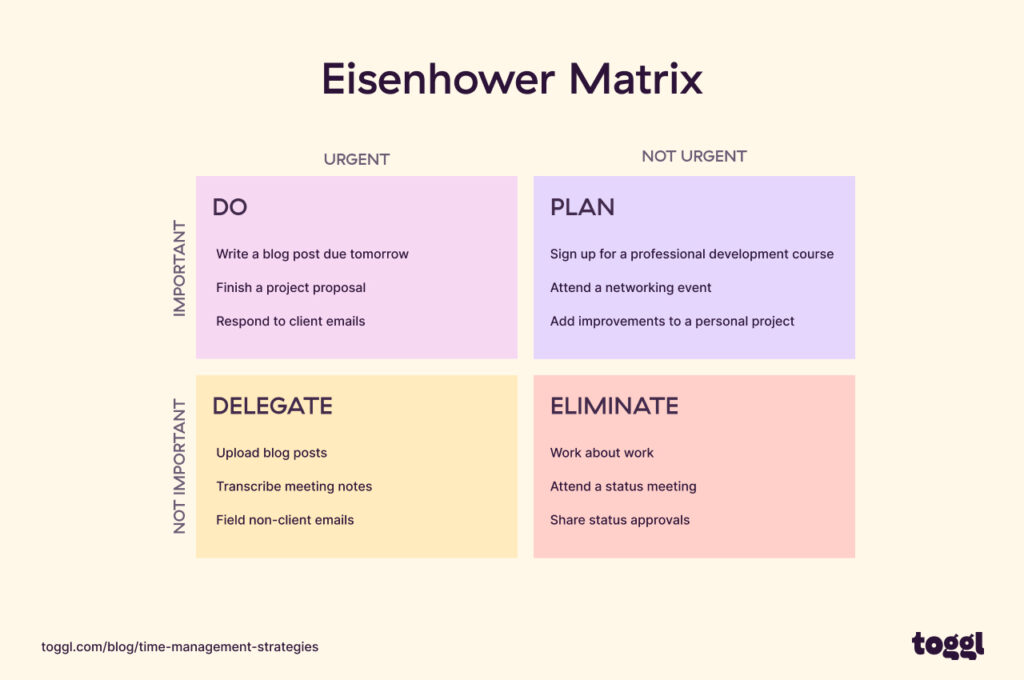In a successful team, each person works in productive harmony to reach their team’s shared goals on time. In reality? Team time management is tough. Different schedules, locations, and productivity approaches make it challenging for managers to get the most from their team members without burning anyone out.
To help you get on track (pun intended 😏) for 2025, we’ve asked our own team what helps with time management to bring you these 11 proven team time management strategies you should start using today to keep your people motivated and in control of their time.
TL;DR—Key Takeaways
- Team time management involves planning employee time to meet project goals, optimize productivity, and maintain team morale.
- Effective time management boosts transparency and collaboration. It reduces stress, cutting the risk of burnout. Intelligent use of time improves work quality and makes missed deadlines far less likely.
- Essential time management tips include tracking time to understand how teams work and assign tasks effectively. Maintaining a healthy work-life balance is vital to keep productivity high.
- The best managers empower team members to manage their schedules by setting rules and training staff to prioritize critical tasks. Employees should be empowered to decline tasks if needed, while regular check-ins promote transparency and share time management ideas.
- Software tools make team time management easier. Collaboration tools and project management software enhance visibility and communication. Time tracking tools also encourage better time management practices, both for individuals and teams.
Why time management is so important for teams
Anyone who manages projects knows time is precious. Every project has a timeframe, and clients hate slippages. At the same time, quality is all-important because no one really cares if you’ve met a deadline if the result is sub-substandard.
So, the key is to learn how to balance efficiency with quality — essentially, how to manage your time without becoming so rigid with your hours that you forget to focus on the end results. Team time management can help with this by keeping everyone on the same page and accountable.
That’s not all, though. Here are a few other benefits you can expect when you commit to team time management.
👀 Time management increases project transparency
With a strong focus on deadlines, milestones, and responsibilities, time management techniques ensure all team members know what they and everyone else are working on. They’ll understand what’s causing any bottlenecks or what work is required to hit the next milestone.
🧘 Time management reduces team stress
Overworking is one of the most common causes of burnout and stress. However, managers can reduce stress levels by allocating manageable schedules that accommodate every team member’s personal circumstances and work-life balance.
Efficient time management also reduces the risk of last-minute panics as deadlines approach. Instead, staff can handle work time methodically, avoiding high stress and activity spikes.
🪢 Time management improves team collaboration
Structured time management encourages smooth collaboration and teamwork. When everybody is clear about what’s needed from them and their colleagues, they can align their efforts and avoid inefficiencies like mismatched schedules and duplicated work.
🌟 Time management boosts quality of work
With only so many hours in the day, managers must decide which goals to devote attention to — you know, the tasks that’ll make or break project success. By doing so, team members focus on the most important tasks, raising the overall quality and precision of their output.
⌛ Time management eliminates procrastination
As a side benefit, good time management promotes employee engagement with their work. Well-defined schedules leave no room for empty periods or procrastination (at least until everyone’s smashed their goals for the day).

11 ways to improve team time management
Now that we’ve covered the “why,” let’s move on to the “how” of implementing time management strategies and improving team performance.
Before we get started, it’s important to clarify team time management is not the same as personal time management. Sure, some of the tips below could be relevant for individuals, but the list refers to time management tips for teams, which is even more complex.
1. Start tracking time to see where you’re at
You need to know how to monitor and quantify time before you can begin to manage it. Using time tracking tools to collect high-quality data lets you see how team members spend their work hours on various workflows. Managers can use this data to stay on course with their goals.
Example: Your marketing team spends 10 hours a week responding to customer inquiries on social media, but only 5% of leads come from that channel. Your time tracking data suggests it might be more effective to allocate fewer resources here and focus on channels with higher lead generation rates.
2. Set clear and measurable goals
Effective time management is all about clarity. Team members need to know the objectives of each task you set and the deadline for each milestone.
Once you’ve set team members up with their individual goals, they should have everything they need to:
- Allocate enough time
- Plan future tasks
- Measure their own progress
Of course, managers should still be involved in overseeing task completion, but this isn’t an excuse to micro-manage. Publishing team goals is one way to solve this, so everyone has visibility into project progress, and managers won’t feel the need to request updates.
3. Introduce rules for effective time management
Time management is not a top-down exercise; it’s universal. Every team member should manage their own time efficiently, and clear rules will help them reach that goal.
We recommend creating time management guidelines before assembling project teams. These guidelines should offer guidance about setting deadlines, using calendar software, and strategies like time blocking or the Pomodoro technique.
It’s important to be realistic, though. Staff members are not machines to squeeze every last ounce of productivity from. They still need to relax between intense work periods. But it’s a good idea to set expectations on how much free time or social media usage they can enjoy within their paid work hours.
Publish your time management policy in your staff handbook, internal wiki, or any other collaboration platform everyone can access. Refer to it regularly, not as a disciplinary tool, but as a valuable resource to encourage productivity.
4. Teach your team how to prioritize important tasks
Team members can often get stuck on minor jobs and neglect tasks that impact project success. The trick is to know which tasks will move the needle and get you closer to your goals.
Effective time management strategies teach colleagues to prioritize their time efficiently. One of our favorites is the Eisenhower Matrix, which simplifies task management and applies to almost any situation.
The Eisenhower Matrix has two axes. One axis includes “urgent” and “non-urgent” tasks. The other axis has entries for “important” and “unimportant” tasks. You can probably sense where this is going.

Tasks map onto the matrix, creating a hierarchy of priorities. Those graded as urgent and important rise to the top, followed by important but non-urgent work. Managers can delegate urgent but less important jobs while striking off tasks deemed neither urgent nor important.
This technique is great for sorting project tasks. Team members can use the matrix to understand their workloads, while managers can delegate and focus on daily or weekly priorities. When you apply the matrix systematically, “forgetting” tasks is much harder — especially the urgent and important ones that make or break projects.
5. Create a culture of declining non-urgent tasks
The Eisenhower Matrix has another advantage: it empowers team members in decision-making.
Colleagues can slide non-urgent tasks to the back of the queue or even challenge managers and decline non-urgent tasks. They can avoid being side-tracked and remain focused on mission-critical work.
This level of empowerment doesn’t just happen. It requires a workspace culture that builds confidence and makes staff feel comfortable declining requests. Here are some suggestions about how to do so:
- React positively when people decline tasks. Ask team members about their reasons and discuss their current workload.
- Use insights from discussions to improve your delegation methods. You may be sending staff too many minor tasks before they complete tasks related to core project goals.
- Use team meetings to reassure colleagues that declining tasks is OK, and that you welcome self-management.
6. Give employees the right collaboration tools
So far, many of our time management techniques have focused on allowing team members to manage their time productively. But here’s the catch. Self-organization won’t happen without the right infrastructure, which is where collaboration tools come into play.
Project management and direct messaging software like Notion or Slack enable seamless communication within teams and encourage a free flow of ideas. Colleagues can check progress in real-time, support each other, and spot tasks requiring attention.
7. Create workload overviews
Teams also need visualization tools to implement time management concepts. Collaboration tools with built-in workload views visually represent teamwork schedules and tasks. Managers can see tasks assigned to team members, making it easier to avoid excessive workloads and balance tasks efficiently.
Workload management matters because burnout is a project killer. Almost 75% of American workers experienced burnout in 2023, with heavy workloads leading the list of causes.
8. Encourage regular breaks (or different working styles)
This might sound strange, but being more flexible about employees’ work schedules and time off can lead to better time management. Whaaaat? How does that work?
As we briefly mentioned at the start, time management can suffer when staff become too focused on single tasks. When people bury themselves in work, they forget to plan their days and set achievable goals. Burnout is just around the corner.
Regular breaks and flexible work days provide space to reflect and recharge. Workers might find better ways to approach time-consuming tasks or return to work with a clear head and an energy boost.
There are many approaches to flexible working. At Toggl, we apply RAFT principles (Results and Accountability First at Toggl) to boost productivity. Employees are free to set their work schedules provided they meet their professional goals. Whatever approach you choose, remember to take breaks seriously. Stepping away from the screen really does help.
9. Offer training to improve time management skills
Managing time is like any other professional challenge — it takes training and practice.
We recommend scheduling team time management workshops annually (or in the early stages of projects.) A few sessions on the Eisenhower Matrix or time blocking will pay huge dividends as your projects proceed.
It’s also important to organize one-on-one sessions between managers and team members to understand individual blockers. Everyone has different distractions and demands on their time. For some, it’s the pull of too many meetings, while others need flexibility to manage families and external commitments. These discussions will help you find tailored solutions for each team member.
Whatever strategy you adopt, focus on building critical time management skills, including:
- Prioritization: Leaning on the Eisenhower Matrix, or similar, to decide which tasks you need to handle right now
- Goal setting: Teaching staff to set achievable targets instead of chaotically working through a pile of tasks
- Avoiding multitasking: Stressing the need to focus on a specific task
- Setting boundaries: Suggesting ways to structure separate work and personal commitments
- Collaboration: Allowing employees to share tasks when needed, optimizing your team’s potential.
10. Conduct regular check-ins with your team
Regular meetings allow you to assess progress and let colleagues raise issues that matter to them. Make meetings friendly and open so team members feel confident asking for a reduced workload or suggesting automation ideas to reduce time spent on mundane tasks.
Your team works on the front line, and they know better than anyone if tasks are unnecessary or inefficient. Use their experience to devise better strategies that align with your business goals.
Remember: Don’t schedule too many check-in meetings, which might defeat the purpose of having them at all. Make sure you’re using time with your team efficiently.
11. Use the right team time management tools
Finally, we feel it’s important to say a bit more about time management tools and how they’ll enhance your project management tech stack.
We’re obviously a little biased (just a lil), but we have seen firsthand how the right time tracking tool can help teams screen out distractions and set block lists so they don’t get sucked into scrolling Facebook, Instagram, or the latest news story.
Ideally, you’ll be able to align restrictions with time blocks, too — creating focus zones and times to let loose and relax. Tools with built-in Pomodoro timers and integrations with popular calendar tools are also a hit.
How Toggl Track can help you implement these time management strategies
Even the best schedulers can benefit from revisiting their time management strategies. After all, everyone is guilty of poor time management from time to time. Nobody is born with perfect scheduling skills, and things can quickly go awry when you’re handling time management across an entire team.
At Toggl Track, we know this from experience. When you lose track of time, stress levels rise, and team productivity suffers. That’s why we’ve created a time tracking tool to empower teams and make every minute count.
We’ve made it easy to manage employee schedules and set individual goals. Reporting functions identify potential bottlenecks or training opportunities because, well, it’s much harder to waste time with data from every team member at your fingertips.
Your team can turn on Focus Mode when they need to concentrate. Flexible time tracking also lets users blend billable hours with non-work activities. Even better, our time tracker integrates with over 100 third-party tools, allowing seamless link-ups with Jira or Todoist.
Call timeout on your scheduling issues
It’s time to find a better way! Explore Toggl Track’s team time tracking features.

Elizabeth is an experienced entrepreneur, writer, and content marketer. She has nine years of experience helping grow businesses, including two of her own, and shares Toggl's mission of challenging traditional beliefs about what building a successful business looks like.




